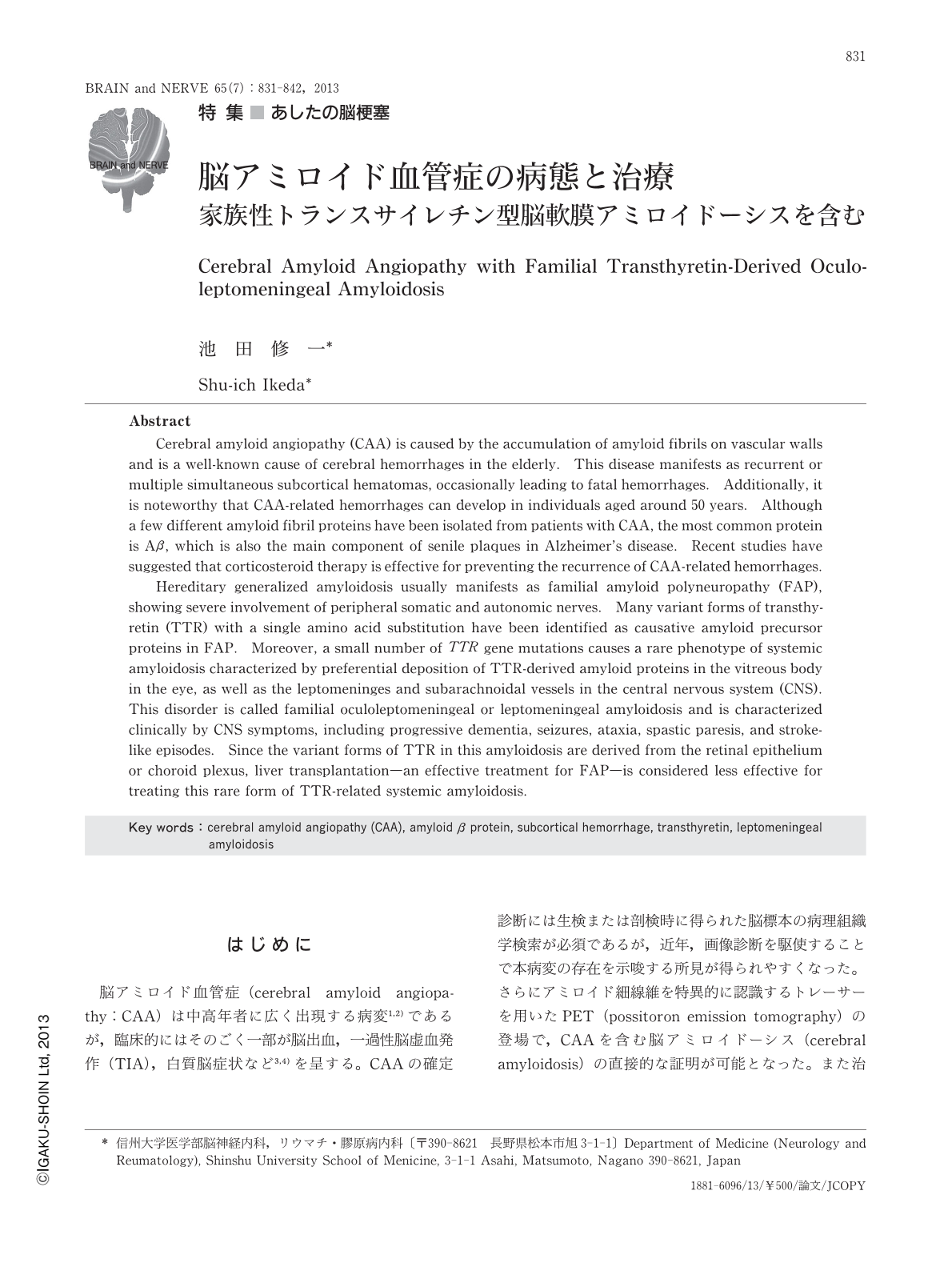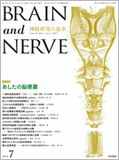Japanese
English
- 有料閲覧
- Abstract 文献概要
- 1ページ目 Look Inside
- 参考文献 Reference
はじめに
脳アミロイド血管症(cerebral amyloid angiopathy:CAA)は中高年者に広く出現する病変1,2)であるが,臨床的にはそのごく一部が脳出血,一過性脳虚血発作(TIA),白質脳症状など3,4)を呈する。CAAの確定診断には生検または剖検時に得られた脳標本の病理組織学検索が必須であるが,近年,画像診断を駆使することで本病変の存在を示唆する所見が得られやすくなった。さらにアミロイド細線維を特異的に認識するトレーサーを用いたPET(possitoron emission tomography)の登場で,CAAを含む脳アミロイドーシス(cerebral amyloidosis)の直接的な証明が可能となった。また治療面でもCAA関連の病態を軽減する薬物療法が提唱されている。
一方,家族性トランスサイレチン(amyloidogenic transthyretin:ATTR;アミロイド惹起性トランスサイレチン)型全身性アミロイドーシスは,末梢の体性(somatic)ならびに自律(autonomic)神経障害を臨床的特徴とする疾患(家族性アミロイド多発ニューロパチーfamilial amyloid polyneuropathy:FAP5))として広く知られているが,ATTR由来アミロイドが脳脊髄の軟膜に選択的に沈着することで進行性の中枢神経障害を生じることがある。本病型はfamilial meningocerebrovascular(家族性髄膜脳血管アミロイドーシス)6)またはoculoleptomeningeal amyloidosis(家族性眼脳軟膜アミロイドーシス)7)と呼称されて,脳表ヘモジデローシスを引き起こす基礎疾患の1つに挙げられ,最近,わが国においても注目されている。
本稿では,CAAとトランスサイレチン関連脳軟膜アミロイドーシスを中心とする中枢神経系のアミロイドーシスと脳血管障害との関連についてその概略を述べる。
Abstract
Cerebral amyloid angiopathy (CAA) is caused by the accumulation of amyloid fibrils on vascular walls and is a well-known cause of cerebral hemorrhages in the elderly. This disease manifests as recurrent or multiple simultaneous subcortical hematomas, occasionally leading to fatal hemorrhages. Additionally, it is noteworthy that CAA-related hemorrhages can develop in individuals aged around 50 years. Although a few different amyloid fibril proteins have been isolated from patients with CAA, the most common protein is Aβ, which is also the main component of senile plaques in Alzheimer's disease. Recent studies have suggested that corticosteroid therapy is effective for preventing the recurrence of CAA-related hemorrhages.
Hereditary generalized amyloidosis usually manifests as familial amyloid polyneuropathy (FAP), showing severe involvement of peripheral somatic and autonomic nerves. Many variant forms of transthyretin (TTR) with a single amino acid substitution have been identified as causative amyloid precursor proteins in FAP. Moreover, a small number of TTR gene mutations causes a rare phenotype of systemic amyloidosis characterized by preferential deposition of TTR-derived amyloid proteins in the vitreous body in the eye, as well as the leptomeninges and subarachnoidal vessels in the central nervous system (CNS). This disorder is called familial oculoleptomeningeal or leptomeningeal amyloidosis and is characterized clinically by CNS symptoms, including progressive dementia, seizures, ataxia, spastic paresis, and stroke-like episodes. Since the variant forms of TTR in this amyloidosis are derived from the retinal epithelium or choroid plexus, liver transplantation―an effective treatment for FAP―is considered less effective for treating this rare form of TTR-related systemic amyloidosis.

Copyright © 2013, Igaku-Shoin Ltd. All rights reserved.


